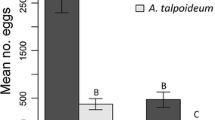Summary
Growth, reproduction, and survivorship of Armadillidium vulgare have been observed when laboratory populations were fed experimental diets consisting of leaves from different species of plant in different states of decay.
Growth and fecundity were highest when the foods consisted of standing dead dicotyledonous plant leaves. Feeding on monocotyledonous material caused increased mortality as well as reducing both growth rates and reproductive output to very low levels. When the dicotyledonous material was extensively decayed before feeding, growth rates and survivorship decreased but this treatment did not significantly alter the results for monocotyledonous foods.
Growth and survivorship rates were not significantly correlated with the total nitrogen content of the food but appeared to be related to the extent to which it could be digested and absorbed across the gut wall.
Some of the implications of these results for the dynamics of field populations of terrestrial isopods are discussed.
Similar content being viewed by others
References
Al Dabbagh KY (1976) Population dynamics and bio-energetics of the terrestrial isopod Armadillidium vulgare (Lat.) in grassland ecosystems. Ph D Thesis University of Leicester
Al Dabbagh KY, Block W (1981) The population ecology of a terrestrial isopod in two breckland grass-heaths. J Anim Ecol 50:61–77
Booth RG, Anderson JM (1979) The influence of fungal food quality on the growth and fecundity of Folsomia canida (Collembola: Isotomidae). Oecologia (Berl) 38:317–323
Darwin C (1886) The origin of species by means of natural selection 6th Edition, Murray, London
Hassall M (1976) Studies on the biology of Philoscia muscorum (Crustacea: Isopoda) with particular reference to its role in a dune grassland ecosystem. Ph D Thesis, University of Leeds
Hasall M (1977) Consumption of leaf litter by the terrestrial isopod Philoscia muscorum in relation to food availability in a dune grassland ecosystem. Ecol Bull (Stockholm) 25:550–553
Hubbell SP (1971) Of sowbugs and systems: the ecological bioenergetics of a terrestrial isopod. Systems analysis and simulation in ecology. Vol 1 (Ed BC Patten) 269–324, Academic Press, New York and London
Hughes RD, Walker J (1970) The role of food in the population dynamicsof the Australian Bush Fly Musca vetustissima. Brit Ecol Soc Symp No 10 Animal populations in relation to their food supply. Watson A (ed) Blackwell, Oxford pp 255–269
Iverson JM (1974) Ingestion and growth in Sericostoma personatum (Trichoptera) in relation to the nitrogen content of ingested leaves. Oikos, 25:278–282
Kheirallah AM, El-Sharkaway K (1981) Growth rate and natality of Porcellio olivieri (Crustacea: Isopoda) on different foods. Pedobiologia 22:262–267
Lawton JH, McNeill S (1979) Between the devil and the deep blue sea: on the problem of being a herbivore. Brit Ecol Soc Symp No 20. Population Dynamics, Anderson R, Turner B, Taylor LR (eds) Ch 11 Blackwell, Oxford pp 223–244
Malthus TR (1798) First essay on population. Macmillan, London 1966
McNeill S, Southwood TRE (1978) The role of nitrogen in the development of insect plant relationships. Ann P Phyt 15:77–98
McQueen DJ (1976a) Procellio spinicornis Say (Isopoda) demography. II A comparison between field and laboratory data. Can J Zool 54:825–842
McQueen DJ (1976b) Porcellio spinicornis Say (Isopoda) demography III A comparison between field data and the results of a simulation model. Can J Zool 54:2174–2184
McQueen DJ (1976c) The influence of climatic factors on the demography of the terrestrial isopod Tracheoniscus rathkei. Can J Zool 54:2185–2199
McQueen DJ, Carnio JS (1974) A laboratory study of the effects of some climatic factors on the demography of the terrestrial isopod Porcellio spinicornis (Say). Can J Zool 52:599–611
Merriam HG (1971) Sensitivity of terrestrial isopod populations (Armadillidium) to food quality differences. Can J Zool 49:667–674
Neuhauser E, Hartenstein RH, Kaplan DL (1981) Growth of the earthworm Eisenia foetida in relation to population density and food rationing. Oikos 35(1):93–98
Rushton SP (1981) The effects of food quality on the population dynamics of Armadillidium vulgare (Latreille) Ph D Thesis, University of East Anglia
Rushton SP, Hassall M (1983) Food and feeding rates of the terrestrial isopod Armadillidium vulgare Latreille
Stachurski A (1968) Emigration, mortality rates and food shelter conditions of Ligidium hypnorum L. (Isopoda) Ekol pol Ser A 16:445–459
Stachurski A (1972) Population density; biomass and maximum natality rate and food conditions in Ligidium hypnorum L. (Isopoda) Ekol pol Ser A 20:185–197
Tsukomoto J (1977) Soil macroanimals on a slope in a deciduous broad leaved forest. I Two species of terrestrial isopoda Ligidium japonicum and L. paulum. Jap J Ecol 26:201–206
Watson A (1970) Animal populations in relation to their food supply. Brit Ecol Soc Sympsoium No 10 Blackwell, Oxford
Watt AS (1940) Studies in the ecology of Breckland. IV The grassheath. J Ecol 28:42–70
White TCR (1978) The importance of a relative shortage of food in animal ecology. Oecologia (Berlin) 33:71–86
Wilkins A (1978) An analysis of the population dynamics of Philoscia muscorum (Isopoda: Oniscoidea) a modelling approach. Ph D Thesis University of Leeds
Author information
Authors and Affiliations
Rights and permissions
About this article
Cite this article
Rushton, S.P., Hassall, M. The effects of food quality on the life history parameters of the terrestrial isopod (Armadillidium vulgare (Latreille)). Oecologia 57, 257–261 (1983). https://doi.org/10.1007/BF00379587
Received:
Issue Date:
DOI: https://doi.org/10.1007/BF00379587




